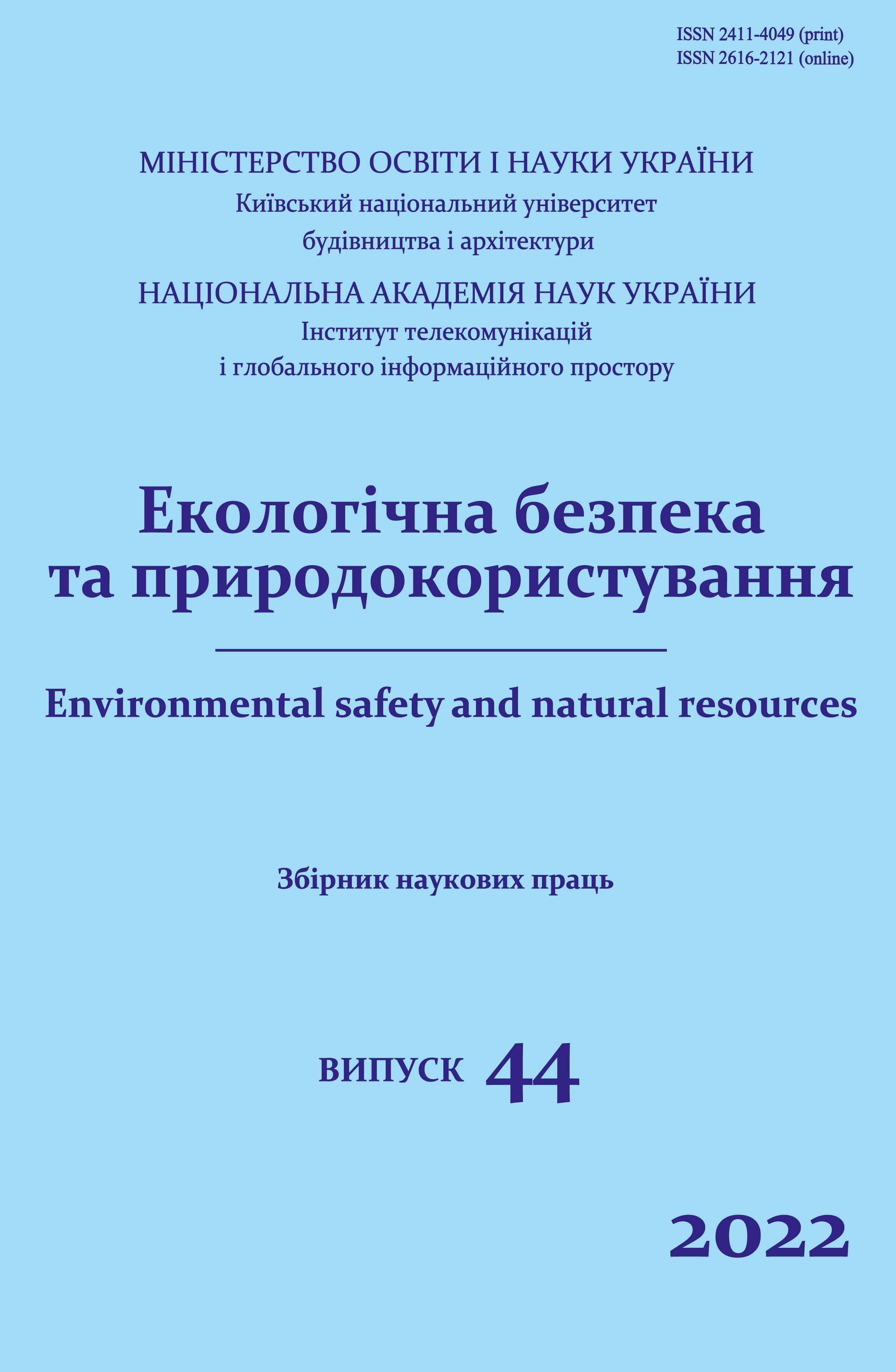Determination of the norms for the transportation of household waste for Hirska amalgamated territorial community settlements
DOI:
https://doi.org/10.32347/2411-4049.2022.4.80-90Keywords:
municipal household waste, mixed household waste, service provision norms, formation normsAbstract
Solving the problem of household waste management is based on determining the amount of waste generated. It is important to conduct research for both urban and rural settlements with different degrees of coverage of the population by a centralized system of collection and removal of household waste in order to obtain more reliable results. The purpose of the work is to improve methodological approaches to determining the norms of providing services for the transportation of household waste in populated areas. Analysis of literature data shows that there is no valid data on field measurements and their results, and there are no consistent forms of presentation of the obtained results. This makes it impossible to compare them and carry out a deeper analysis to identify the dependence of the calculated accumulation rates on the population and the level of coverage by the centralized collection system and transportation of household waste in cities, territorial communities and villages. This article presents field studies performed to determine the volume of household waste generation from the sources of its generation. On-site measurements were carried out on the territory of the Hirska Amalgamated Territorial Community.
References
Pro zatverdzhennja Pravyl vyznachennja norm nadannja poslug z vyvezennja pobutovyh vidhodiv, Nakaz Ministerstva z pytan' zhytlovo-komunal'nogo gospodarstva Ukrai'ny № 259 (2021) (Ukrai'na). Retrieved from: https://zakon.rada.gov.ua/laws/show/z0871-10#Text [in Ukrainian].
Kocjuba, I. G., Shherbatjuk, A. F., & Godovs'ka, T. B. (2016). Prognozuvannja obsjagiv utvorennja tverdyh pobutovyh vidhodiv v misti Zhytomyri. Visnyk Nacional'nogo tehnichnogo universytetu «HPI». Serija: Mehaniko-tehnologichni systemy ta kompleksy, (7), 95–100. Retrieved from: http://mtsc.khpi.edu.ua/article/view/93183 [in Ukrainian].
Burjak, N. B., & Lukash, S. V. (2012). Problemy zbyrannja, transportuvannja ta utylizacii' tverdyh pobutovyh vidhodiv v Ukrai'ni. Naukovyj visnyk NLTU Ukrai'ny, (5), 82–90 [in Ukrainian].
Pryhod'ko, V. Ju. (2019). Doslidzhennja regional'nyh osoblyvostej zahoronennja tverdyh pobutovyh vidhodiv v Ukrai'ni. Visnyk Harkivs'kogo nacional'nogo universytetu imeni VN Karazina Serija "Ekologija", (21), 51–62 [in Ukrainian].
Maslovs'kyj, M. A., & Shanina, T. P. (b. d.). Neodnoridnist' umov utvorennja tverdyh pobutovyh vidhodiv u Kyi'vs'komu rajoni mista Odesy. U Galuzevi problemy ekologichnoi' bezpeky (pp. 112–114) [in Ukrainian].
Rjabichev, V. D., & Kijashhenko, V. V. (2011). Tverdi pobutovi vidhody – ekologichna zagroza mista. U IV Mizhnarodna naukovo-praktychna konferencija "Ekonomichni, ekologichni ta social'ni problemy vugil'nyh regioniv SND" (pp. 171–174). Shidnoukrai'ns'kyj nacional'nyj universytet imeni Volodymyra Dalja [in Ukrainian].
Hramcova, A. M., & Kocjuba, I. G. (2017). Prognozuvannja obsjagiv utvorennja tverdyh pobutovyh vidhodiv v misti Zhytomyri. U Tezy Vseukrai'ns'koi' naukovo-praktychnoi' on-line konferencii' aspirantiv, molodyh uchenyh ta studentiv, prysvjachenoi' Dnju nauky (pp. 241–241). ZhDTU [in Ukrainian].
Huang, L., Cai, T., Zhu, Y., Zhu, Y., Wang, W., & Sun, K. (2020). LSTM-Based forecasting for urban construction waste generation. Sustainability, 12(20), 8555. https://doi.org/10.3390/su12208555.
Soni, U., Roy, A., Verma, A., & Jain, V. (2019). Forecasting municipal solid waste generation using artificial intelligence models – a case study in India. SN Applied Sciences, 1(2). https://doi.org/10.1007/s42452-018-0157-x.
Al-Khatib, I. A., Eleyan, D., & Garfield, J. (2015). A system dynamics model to predict municipal waste generation and management costs in developing areas. The Journal of Solid Waste Technology and Management, 41(2), 109–120. https://doi.org/10.5276/jswtm.2015.109.
Chhay, L., Reyad, M. A. H., Suy, R., Islam, M. R., & Mian, M. M. (2018). Municipal solid waste generation in China: Influencing factor analysis and multi-model forecasting. Journal of Material Cycles and Waste Management, 20(3), 1761–1770. https://doi.org/10.1007/s10163-018-0743-4.
Minousepehr, M., Alizadeh, M. R., & Talebbeydokhti, N. (2017). Performance assessment of computational intelligence techniques in solid waste generation forecasting: (A case study). Civil and Environmental Engineering, 67–75.
Hoang, Minh & Pham Phu, Song Toan & K.T., Nguyen & Fujiwara, Takeshi. (2017). Predicting waste generation using Bayesian model averaging. Global Journal of Environmental Science and Management, 3, 385-402. https://doi.org/10.22034/GJESM.2017.03.04.005.
Klavenieks, K., & Blumberga, D. (2016). Forecast of waste generation dynamics in latvia. Energy Procedia, 95, 200–207. https://doi.org/10.1016/j.egypro.2016.09.049.
Moruf, A. A., Oluwasinaayomi, F. K., & Mubarak, O. L. (2020). Public-Private Partnership (PPP) in residential solid waste management in Ibadan: Challenges and opportunities. Journal of Geography and Regional Planning, 13(1), 30–40. https://doi.org/10.5897/jgrp2019.0721.
Aparcana, S. (2017). Approaches to formalization of the informal waste sector into municipal solid waste management systems in low- and middle-income countries: Review of barriers and success factors. Waste Management, 61, 593–607. https://doi.org/10.1016/j.wasman.2016.12.028.
Ferronato, N., & Torretta, V. (2019). Waste mismanagement in developing countries: A review of global issues. International Journal of Environmental Research and Public Health, 16(6), 1060. https://doi.org/10.3390/ijerph16061060.
Sinha, R., Michelsen, J. D., Akcura, E., & Njie, L. (n.d.). COVID-19’s impact on the waste sector. Retrieved from: https://www.ifc.org/wps/wcm/connect/dfbceda0-847d-4c16-9772-15c6afdc8d85/202006-COVID-19-impact-on-waste-sector.pdf?MOD=AJPERES&CVID=na-eKpI.
Kulkarni, B. N., & Anantharama, V. (2020). Repercussions of COVID-19 pandemic on municipal solid waste management: Challenges and opportunities. Science of the Total Environment, 743, 140693. https://doi.org/10.1016/j.scitotenv.2020.140693.
Mol, M. P. G., & Caldas, S. (2020). Can the human coronavirus epidemic also spread through solid waste? Waste Management & Research, 38(5), 485–486. https://doi.org/10.1177/0734242x20918312.
Rajmohan, K. V. S., Ramya, C., Raja Viswanathan, M., & Varjani, S. (2019). Plastic pollutants: Effective waste management for pollution control and abatement. Current Opinion in Environmental Science & Health, 12, 72–84. https://doi.org/10.1016/j.coesh.2019.08.006.
Downloads
Published
How to Cite
Issue
Section
License
Copyright (c) 2022 I.V. Satin, S.V. Khytruk, O.S. Panchenko

This work is licensed under a Creative Commons Attribution 4.0 International License.
The journal «Environmental safety and natural resources» works under Creative Commons Attribution 4.0 International (CC BY 4.0).
The licensing policy is compatible with the overwhelming majority of open access and archiving policies.

